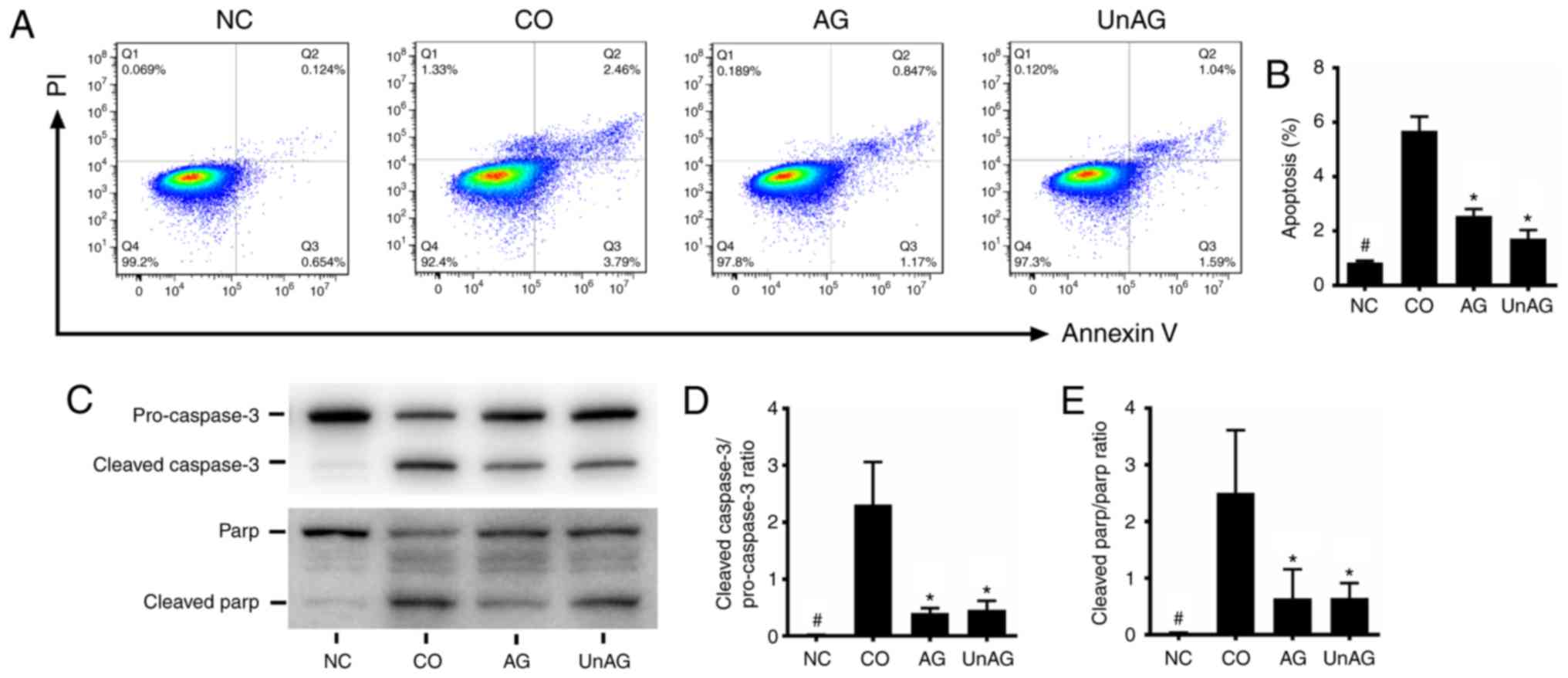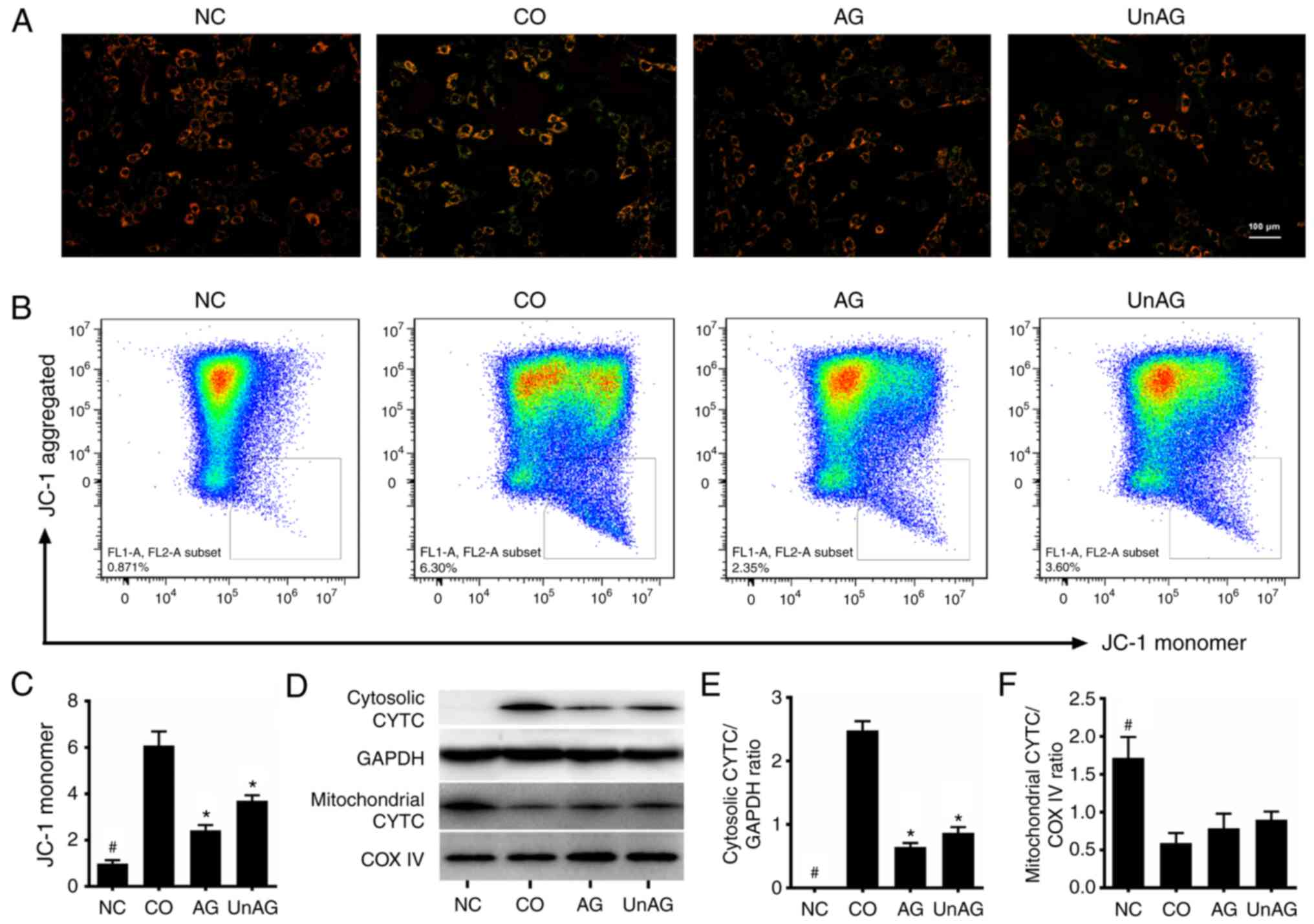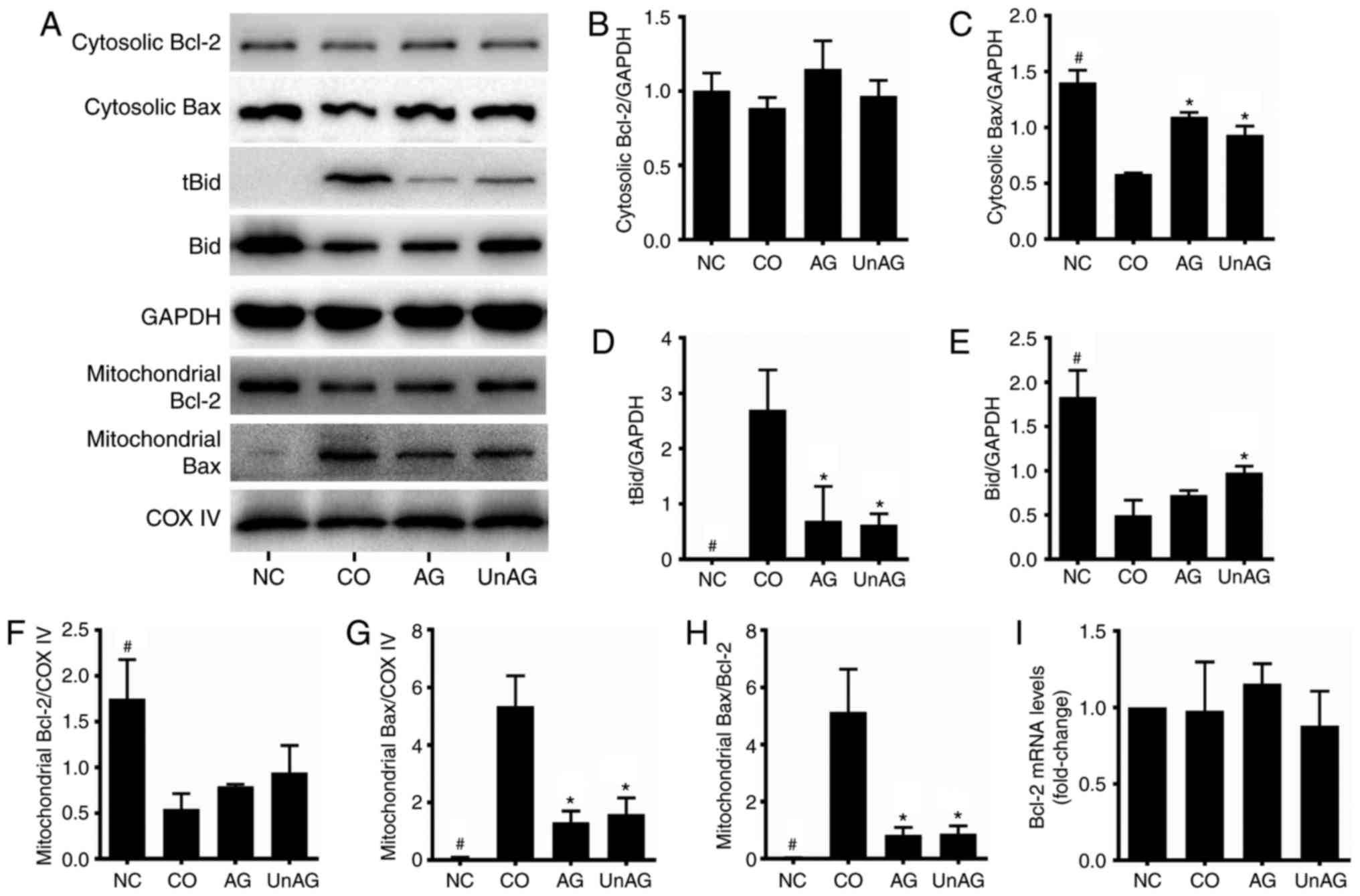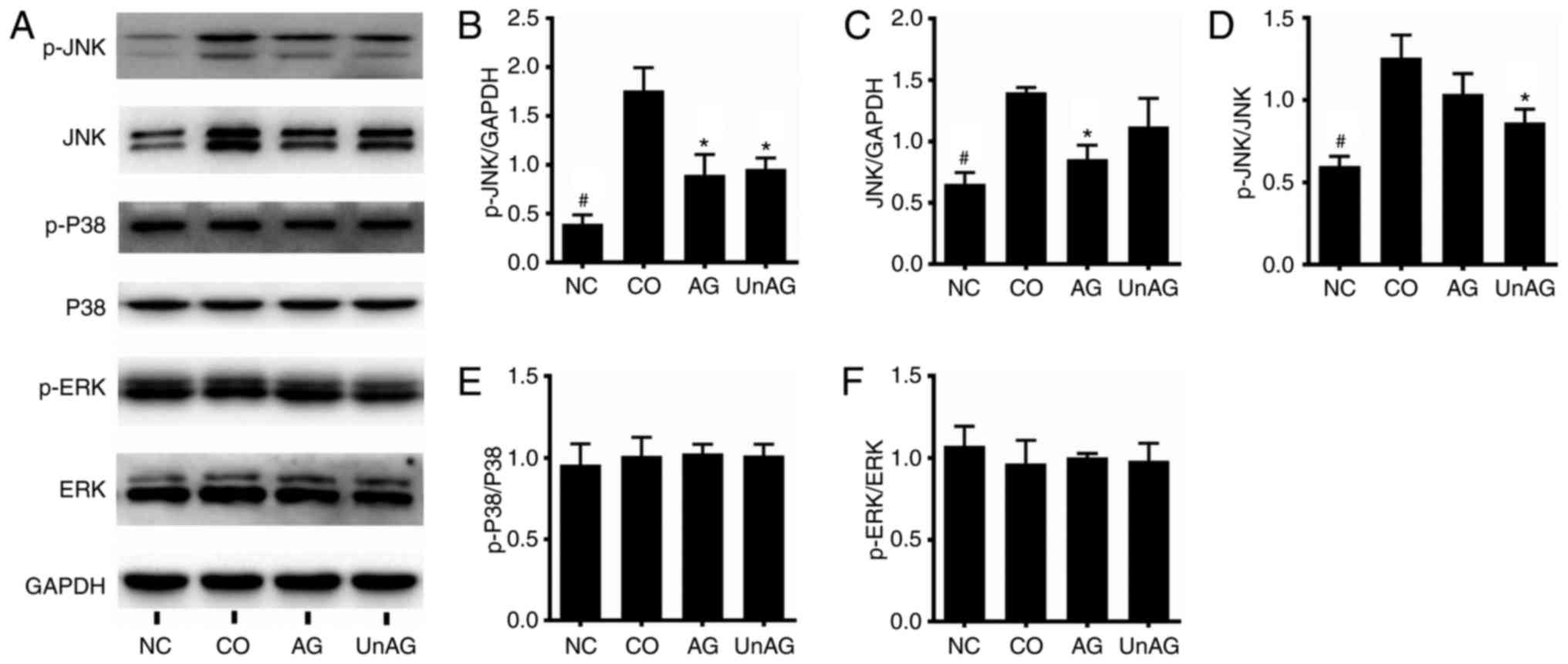|
1
|
Fearon K, Strasser F, Anker SD, Bosaeus I,
Bruera E, Fainsinger RL, Jatoi A, Loprinzi C, MacDonald N,
Mantovani G, et al: Definition and classification of cancer
cachexia: An international consensus. Lancet Oncol. 12:489–495.
2011. View Article : Google Scholar : PubMed/NCBI
|
|
2
|
Donohoe CL, Ryan AM and Reynolds JV:
Cancer cachexia: Mechanisms and clinical implications.
Gastroenterol Res Pract. 2011:6014342011. View Article : Google Scholar : PubMed/NCBI
|
|
3
|
Glass DJ: Signaling pathways perturbing
muscle mass. Curr Opin Clin Nutr Metab Care. 13:225–229. 2010.
View Article : Google Scholar : PubMed/NCBI
|
|
4
|
Schiaffino S, Dyar KA, Ciciliot S, Blaauw
B and Sandri M: Mechanisms regulating skeletal muscle growth and
atrophy. FEBS J. 280:4294–4314. 2013. View Article : Google Scholar : PubMed/NCBI
|
|
5
|
Busquets S, Figueras MT, Fuster G,
Almendro V, Moore-Carrasco R, Ametller E, Argilés JM and
López-Soriano FJ: Anticachectic effects of formoterol: A drug for
potential treatment of muscle wasting. Cancer Res. 64:6725–6731.
2004. View Article : Google Scholar : PubMed/NCBI
|
|
6
|
Ishiko O, Sumi T, Yoshida H, Hyun Y and
Ogita S: Expression of apoptosis regulatory proteins in the
skeletal muscle of tumor-bearing rabbits compared with
diet-restricted rabbits. Int J Mol Med. 8:279–283. 2001.PubMed/NCBI
|
|
7
|
Belizário JE, Lorite MJ and Tisdale MJ:
Cleavage of caspases-1, −3, −6, −8 and −9 substrates by proteases
in skeletal muscles from mice undergoing cancer cachexia. Br J
Cancer. 84:1135–1140. 2001. View Article : Google Scholar : PubMed/NCBI
|
|
8
|
He WA, Berardi E, Cardillo VM, Acharyya S,
Aulino P, Thomas-Ahner J, Wang J, Bloomston M, Muscarella P, Nau P,
et al: NF-κB-mediated Pax7 dysregulation in the muscle
microenvironment promotes cancer cachexia. J Clin Invest.
123:4821–4835. 2013. View
Article : Google Scholar : PubMed/NCBI
|
|
9
|
Bossola M, Marzetti E, Rosa F and Pacelli
F: Skeletal muscle regeneration in cancer cachexia. Clin Exp
Pharmacol Physiol. 43:522–527. 2016. View Article : Google Scholar : PubMed/NCBI
|
|
10
|
Chargé SB and Rudnicki MA: Cellular and
molecular regulation of muscle regeneration. Physiol Rev.
84:209–238. 2004. View Article : Google Scholar : PubMed/NCBI
|
|
11
|
Talbert EE and Guttridge DC: Impaired
regeneration: A role for the muscle microenvironment in cancer
cachexia. Semin Cell Dev Biol. 54:82–91. 2016. View Article : Google Scholar : PubMed/NCBI
|
|
12
|
He WA, Calore F, Londhe P, Canella A,
Guttridge DC and Croce CM: Microvesicles containing miRNAs promote
muscle cell death in cancer cachexia via TLR7. Proc Natl Acad Sci
USA. 111:pp. 4525–4529. 2014; View Article : Google Scholar : PubMed/NCBI
|
|
13
|
Hotchkiss RS, Strasser A, McDunn JE and
Swanson PE: Cell death. N Engl J Med. 361:1570–1583. 2009.
View Article : Google Scholar : PubMed/NCBI
|
|
14
|
Green DR: Apoptotic pathways: Ten minutes
to dead. Cell. 121:671–674. 2005. View Article : Google Scholar : PubMed/NCBI
|
|
15
|
Moldoveanu T, Follis AV, Kriwacki RW and
Green DR: Many players in BCL-2 family affairs. Trends Biochem Sci.
39:101–111. 2014. View Article : Google Scholar : PubMed/NCBI
|
|
16
|
Deng Y, Ren X, Yang L, Lin Y and Wu X: A
JNK-dependent pathway is required for TNFalpha-induced apoptosis.
Cell. 115:61–70. 2003. View Article : Google Scholar : PubMed/NCBI
|
|
17
|
Gnanapavan S, Kola B, Bustin SA, Morris
DG, McGee P, Fairclough P, Bhattacharya S, Carpenter R, Grossman AB
and Korbonits M: The tissue distribution of the mRNA of ghrelin and
subtypes of its receptor, GHS-R, in humans. J Clin Endocrinol
Metab. 87:29882002. View Article : Google Scholar : PubMed/NCBI
|
|
18
|
Molfino A, Gioia G and Muscaritoli M: The
hunger hormone ghrelin in cachexia. Expert Opin Biol Ther.
13:465–468. 2013. View Article : Google Scholar : PubMed/NCBI
|
|
19
|
Chopin L, Walpole C, Seim I, Cunningham P,
Murray R, Whiteside E, Josh P and Herington A: Ghrelin and cancer.
Mol Cell Endocrinol. 340:65–69. 2011. View Article : Google Scholar : PubMed/NCBI
|
|
20
|
Guillory B, Splenser A and Garcia J: The
role of ghrelin in anorexia-cachexia syndromes. Vitam Horm.
92:61–106. 2013. View Article : Google Scholar : PubMed/NCBI
|
|
21
|
Filigheddu N, Gnocchi VF, Coscia M,
Cappelli M, Porporato PE, Taulli R, Traini S, Baldanzi G, Chianale
F, Cutrupi S, et al: Ghrelin and des-acyl ghrelin promote
differentiation and fusion of C2C12 skeletal muscle cells. Mol Biol
Cell. 18:986–994. 2007. View Article : Google Scholar : PubMed/NCBI
|
|
22
|
Baldanzi G, Filigheddu N, Cutrupi S,
Catapano F, Bonissoni S, Fubini A, Malan D, Baj G, Granata R,
Broglio F, et al: Ghrelin and des-acyl ghrelin inhibit cell death
in cardiomyocytes and endothelial cells through ERK1/2 and PI
3-kinase/AKT. J Cell Biol. 159:1029–1037. 2002. View Article : Google Scholar : PubMed/NCBI
|
|
23
|
Chung H, Seo S, Moon M and Park S:
Phosphatidylinositol-3-kinase/Akt/glycogen synthase kinase-3 beta
and ERK1/2 pathways mediate protective effects of acylated and
unacylated ghrelin against oxygen-glucose deprivation-induced
apoptosis in primary rat cortical neuronal cells. J Endocrinol.
198:511–521. 2008. View Article : Google Scholar : PubMed/NCBI
|
|
24
|
Mao Y, Wang J, Yu F, Li Z, Li H, Guo C and
Fan X: Ghrelin protects against palmitic acid or
lipopolysaccharide-induced hepatocyte apoptosis through inhibition
of MAPKs/iNOS and restoration of Akt/eNOS pathways. Biomed
Pharmacother. 84:305–313. 2016. View Article : Google Scholar : PubMed/NCBI
|
|
25
|
Yu J, Xu H, Shen X and Jiang H: Ghrelin
protects MES23.5 cells against rotenone via inhibiting
mitochondrial dysfunction and apoptosis. Neuropeptides. 56:69–74.
2016. View Article : Google Scholar : PubMed/NCBI
|
|
26
|
Zhang Q, Huang WD, Lv XY and Yang YM:
Ghrelin protects H9c2 cells from hydrogen peroxide-induced
apoptosis through NF-κB and mitochondria-mediated signaling. Eur J
Pharmacol. 654:142–149. 2011. View Article : Google Scholar : PubMed/NCBI
|
|
27
|
Galluzzi L, Vitale I, Abrams JM, Alnemri
ES, Baehrecke EH, Blagosklonny MV, Dawson TM, Dawson VL, El-Deiry
WS, Fulda S, et al: Molecular definitions of cell death
subroutines: Recommendations of the nomenclature committee on cell
death 2012. Cell Death Differ. 19:107–120. 2012. View Article : Google Scholar : PubMed/NCBI
|
|
28
|
Kroemer G, Galluzzi L and Brenner C:
Mitochondrial membrane permeabilization in cell death. Physiol Rev.
87:99–163. 2007. View Article : Google Scholar : PubMed/NCBI
|
|
29
|
Li P, Nijhawan D, Budihardjo I,
Srinivasula SM, Ahmad M, Alnemri ES and Wang X: Cytochrome c and
dATP-dependent formation of Apaf-1/caspase-9 complex initiates an
apoptotic protease cascade. Cell. 91:479–489. 1997. View Article : Google Scholar : PubMed/NCBI
|
|
30
|
Zou H, Henzel WJ, Liu X, Lutschg A and
Wang X: Apaf-1, a human protein homologous to C. elegans CED-4,
participates in cytochrome c-dependent activation of caspase-3.
Cell. 90:405–413. 1997. View Article : Google Scholar : PubMed/NCBI
|
|
31
|
Hsu YT, Wolter KG and Youle RJ:
Cytosol-to-membrane redistribution of Bax and Bcl-XL
during apoptosis. Proc Natl Acad Sci USA. 94:pp. 3668–3672. 1997;
View Article : Google Scholar : PubMed/NCBI
|
|
32
|
Wolter KG, Hsu YT, Smith CL, Nechushtan A,
Xi XG and Youle RJ: Movement of Bax from the cytosol to
mitochondria during apoptosis. J Cell Biol. 139:1281–1292. 1997.
View Article : Google Scholar : PubMed/NCBI
|
|
33
|
Gross A, Jockel J, Wei MC and Korsmeyer
SJ: Enforced dimerization of BAX results in its translocation,
mitochondrial dysfunction and apoptosis. EMBO J. 17:3878–3885.
1998. View Article : Google Scholar : PubMed/NCBI
|
|
34
|
Yamamoto K, Ichijo H and Korsmeyer SJ:
BCL-2 is phosphorylated and inactivated by an ASK1/Jun N-terminal
protein kinase pathway normally activated at G2/M. Mol
Cell Biol. 19:8469–8478. 1999. View Article : Google Scholar : PubMed/NCBI
|
|
35
|
Willimott S and Wagner SD:
Post-transcriptional and post-translational regulation of Bcl2.
Biochem Soc Trans. 38:1571–1575. 2010. View Article : Google Scholar : PubMed/NCBI
|
|
36
|
Walensky LD: Direct BAKtivation. Nat
Struct Mol Biol. 20:536–538. 2013. View Article : Google Scholar : PubMed/NCBI
|
|
37
|
De Chiara G, Marcocci ME, Torcia M,
Lucibello M, Rosini P, Bonini P, Higashimoto Y, Damonte G,
Armirotti A, Amodei S, et al: Bcl-2 Phosphorylation by p38 MAPK:
Identification of target sites and biologic consequences. J Biol
Chem. 281:21353–21361. 2006. View Article : Google Scholar : PubMed/NCBI
|
|
38
|
Kyriakis JM and Avruch J: Mammalian
MAP004B signal transduction pathways activated by stress and
inflammation: A 10-year update. Physiol Rev. 92:689–737. 2012.
View Article : Google Scholar : PubMed/NCBI
|
|
39
|
Yamaguchi H and Wang HG: The protein
kinase PKB/Akt regulates cell survival and apoptosis by inhibiting
Bax conformational change. Oncogene. 20:7779–7786. 2001. View Article : Google Scholar : PubMed/NCBI
|
|
40
|
Zhu Z, Dai J, Liao Y and Wang T: Sox9
protects against human lung fibroblast cell apoptosis induced by
LPS through activation of the AKT/GSK3β pathway. Biochemistry.
82:606–612. 2017.PubMed/NCBI
|
|
41
|
Li S, Chen JW, Xie X, Tian J, Deng C, Wang
J, Gan HN and Li F: Autophagy inhibitor regulates apoptosis and
proliferation of synovial fibroblasts through the inhibition of
PI3K/AKT pathway in collagen-induced arthritis rat model. Am J
Transl Res. 9:2065–2076. 2017.PubMed/NCBI
|
|
42
|
Fearon KC, Glass DJ and Guttridge DC:
Cancer cachexia: Mediators, signaling, and metabolic pathways. Cell
Metab. 16:153–166. 2012. View Article : Google Scholar : PubMed/NCBI
|
|
43
|
Argiles JM, Busquets S, Stemmler B and
López-Soriano FJ: Cancer cachexia: Understanding the molecular
basis. Nat Rev Cancer. 14:754–762. 2014. View Article : Google Scholar : PubMed/NCBI
|
|
44
|
Granata R, Settanni F, Biancone L, Trovato
L, Nano R, Bertuzzi F, Destefanis S, Annunziata M, Martinetti M,
Catapano F, et al: Acylated and unacylated ghrelin promote
proliferation and inhibit apoptosis of pancreatic beta-cells and
human islets: Involvement of 3′,5′-cyclic adenosine
monophosphate/protein kinase a, extracellular signal-regulated
kinase 1/2, and phosphatidyl inositol 3-Kinase/Akt signaling.
Endocrinology. 148:512–529. 2007. View Article : Google Scholar : PubMed/NCBI
|
|
45
|
Tsubouchi H, Yanagi S, Miura A, Matsumoto
N, Kangawa K and Nakazato M: Ghrelin relieves cancer cachexia
associated with the development of lung adenocarcinoma in mice. Eur
J Pharmacol. 743:1–10. 2014. View Article : Google Scholar : PubMed/NCBI
|
|
46
|
Penna F, Costamagna D, Pin F, Camperi A,
Fanzani A, Chiarpotto EM, Cavallini G, Bonelli G, Baccino FM and
Costelli P: Autophagic degradation contributes to muscle wasting in
cancer cachexia. Am J Pathol. 182:1367–1378. 2013. View Article : Google Scholar : PubMed/NCBI
|
|
47
|
Wohlers LM, Powers BL, Chin ER and
Spangenburg EE: Using a novel coculture model to dissect the role
of intramuscular lipid load on skeletal muscle insulin
responsiveness under reduced estrogen conditions. Am J Physiol
Endocrinol Metab. 304:E1199–E1212. 2013. View Article : Google Scholar : PubMed/NCBI
|
|
48
|
Voss JO, Loebel C, Bara JJ, Fussinger MA,
Duttenhoefer F, Alini M and Stoddart MJ: Effect of short-term
stimulation with interleukin-1β and differentiation medium on human
mesenchymal stromal cell paracrine activity in coculture with
osteoblasts. Biomed Res Int. 2015:7142302015. View Article : Google Scholar : PubMed/NCBI
|
|
49
|
Sheriff S, Kadeer N, Joshi R, Friend LA,
James JH and Balasubramaniam A: Des-acyl ghrelin exhibits
pro-anabolic and anti-catabolic effects on C2C12 myotubes exposed
to cytokines and reduces burn-induced muscle proteolysis in rats.
Mol Cell Endocrinol. 351:286–295. 2012. View Article : Google Scholar : PubMed/NCBI
|
|
50
|
Porporato PE, Filigheddu N, Reano S,
Ferrara M, Angelino E, Gnocchi VF, Prodam F, Ronchi G, Fagoonee S,
Fornaro M, et al: Acylated and unacylated ghrelin impair skeletal
muscle atrophy in mice. J Clin Invest. 123:611–622. 2013.PubMed/NCBI
|















